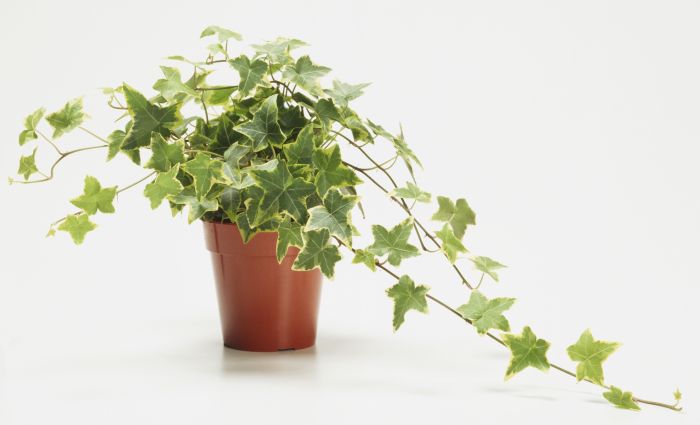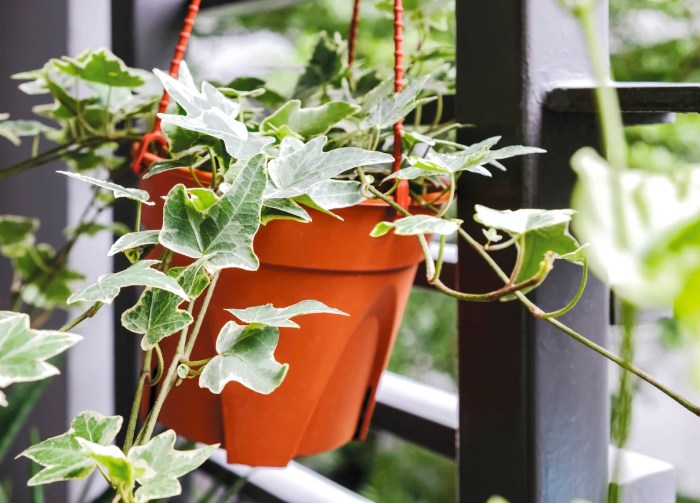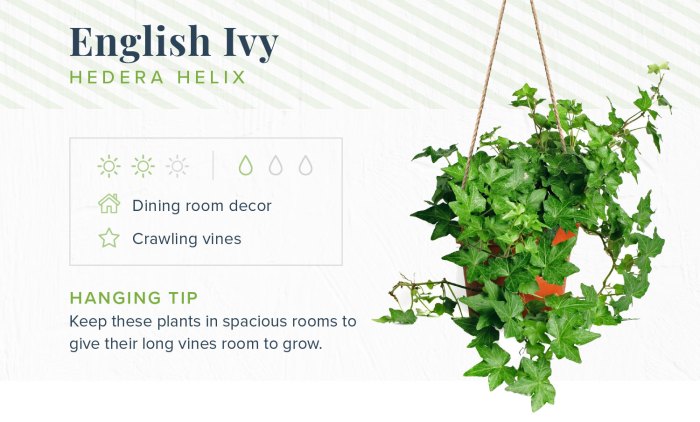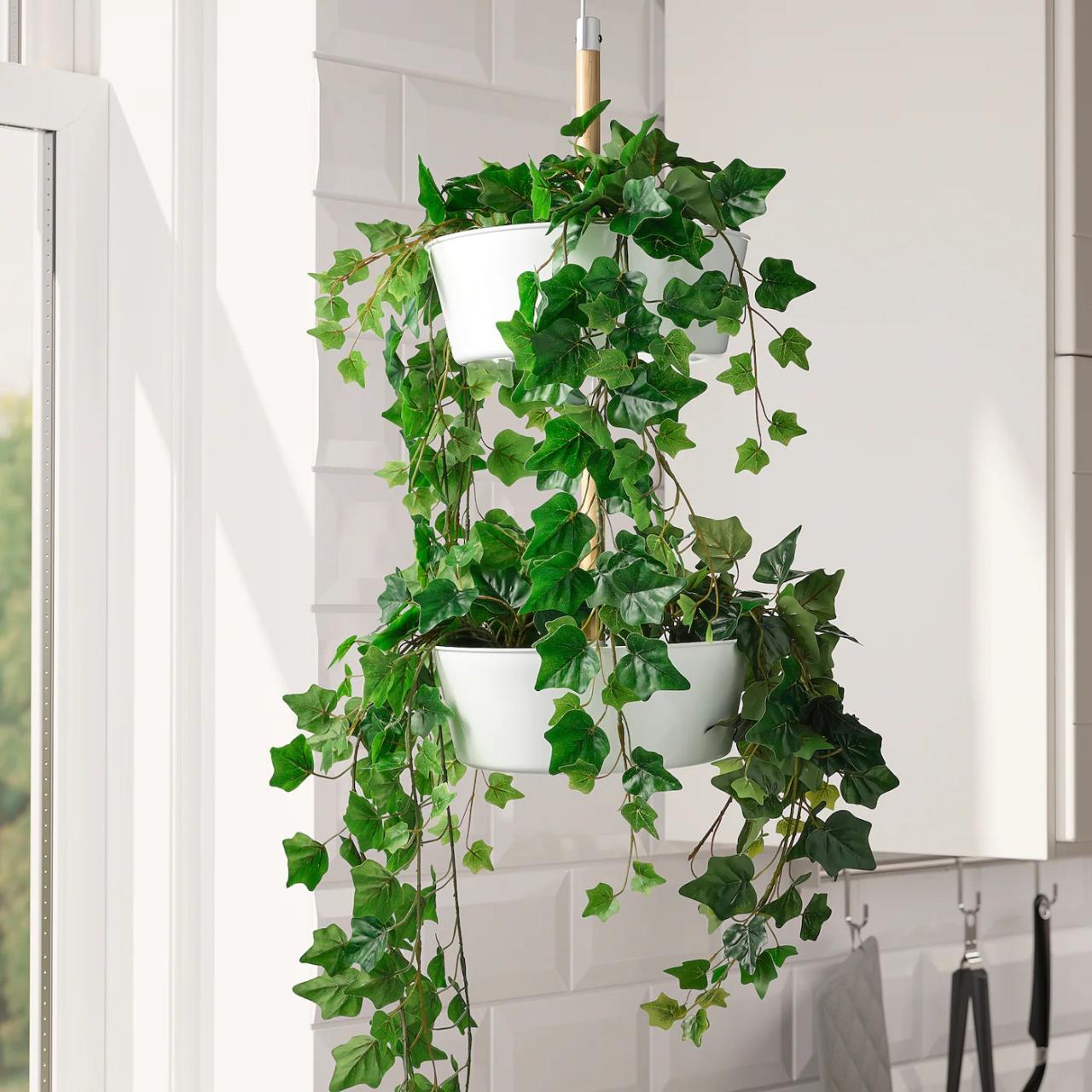Introducing the English ivy indoor hanging plant, a captivating addition to any indoor space. Its cascading foliage and air-purifying qualities make it an ideal choice for those seeking both aesthetic appeal and improved indoor air quality.
This versatile plant thrives in various indoor environments, adding a touch of nature and tranquility to homes, offices, and other indoor settings.
Botanical Characteristics

English ivy (Hedera helix) is a popular indoor hanging plant known for its attractive foliage and easy-going nature. It belongs to the Araliaceae family and is native to Europe, Western Asia, and Northern Africa.
English ivy exhibits a trailing growth habit, with long, slender stems that can reach several meters in length. The stems are covered in small, dark green leaves with three to five lobes. The leaves are arranged alternately along the stem and have a leathery texture.
In mature plants, English ivy can produce small, greenish-yellow flowers in clusters during the fall and winter months.
Growth Habits
English ivy is a vigorous climber that uses aerial roots to attach itself to surfaces. It can climb up walls, trellises, and other structures, making it a suitable choice for vertical gardening. The plant’s ability to cling to surfaces allows it to access sunlight and support, enabling it to thrive in both indoor and outdoor environments.
Indoor Growing Conditions
English ivy is relatively easy to care for indoors. It prefers bright, indirect light but can tolerate low-light conditions. The plant prefers well-drained soil that is kept consistently moist but not soggy. Optimal temperatures for English ivy range from 18 to 24 degrees Celsius (65 to 75 degrees Fahrenheit), and it thrives in moderate humidity levels.
Benefits of English Ivy as an Indoor Hanging Plant: English Ivy Indoor Hanging Plant

English ivy ( Hedera helix) is a versatile and popular choice for indoor hanging plants, offering a range of benefits that enhance both air quality and aesthetics.
English ivy is a versatile indoor hanging plant known for its cascading vines and air-purifying abilities. If you’re seeking low-maintenance greenery, explore our guide to easy maintenance hanging plants , which includes english ivy alongside other resilient options like spider plants and pothos.
English ivy’s tolerance for low light and infrequent watering makes it an ideal choice for busy individuals seeking a touch of nature indoors.
Air-Purifying Qualities
English ivy is known for its air-purifying capabilities. It effectively removes harmful toxins from the air, including benzene, formaldehyde, and trichloroethylene. These toxins are commonly found in household products, cleaning agents, and building materials, and can contribute to health problems such as headaches, nausea, and respiratory issues.
By absorbing and filtering these toxins, English ivy helps improve indoor air quality, creating a healthier living environment.
Aesthetic Appeal
English ivy adds a touch of nature and tranquility to indoor spaces with its cascading foliage and lush greenery. Its long, trailing stems can be trained to hang gracefully from baskets or planters, creating a visually appealing display. The leaves of English ivy vary in shape and size, ranging from heart-shaped to lobed, and come in a variety of shades of green.
This versatility allows it to complement different decor styles, from modern to traditional.
Natural Ambiance, English ivy indoor hanging plant
The presence of plants in indoor spaces has been shown to have a calming and restorative effect on individuals. English ivy, with its lush foliage and natural appearance, can help create a sense of tranquility and reduce stress levels. It brings a touch of the outdoors into indoor environments, fostering a connection with nature and promoting overall well-being.
English ivy is an elegant indoor hanging plant known for its trailing vines. If you’re seeking easy-to-care-for trailing house plants, you may want to consider exploring more options by visiting easy trailing house plants . English ivy remains a popular choice among these options, offering a lush and cascading effect that can enhance any indoor space.
Care and Maintenance of English Ivy

Maintaining English ivy as an indoor hanging plant requires proper care and attention to ensure its health and aesthetic appeal. Understanding its watering, fertilizing, pruning, and pest management needs is essential for successful cultivation.
Watering:English ivy prefers moist soil but not waterlogged conditions. Water thoroughly when the top inch of soil feels dry to the touch. Avoid overwatering, as it can lead to root rot. During the growing season, water more frequently (every 1-2 weeks), reducing frequency during the winter months.
Fertilizing
Fertilize English ivy monthly during the growing season with a balanced liquid fertilizer diluted to half strength. Avoid over-fertilizing, as it can burn the plant. Use a slow-release fertilizer during the winter months to provide sustained nutrition.
Pruning and Shaping
Regular pruning helps maintain the desired shape and size of English ivy. Prune stems that are too long or unruly, cutting just above a leaf node. Trim any dead or damaged leaves. Pruning also encourages new growth and keeps the plant looking healthy.
Pest and Disease Management
English ivy is generally pest-free, but it can be susceptible to spider mites, aphids, and mealybugs. Treat infestations promptly with insecticidal soap or neem oil. Avoid using harsh chemical pesticides indoors.
Design Considerations for Indoor Hanging English Ivy

Incorporating English ivy into your indoor décor can enhance the ambiance and create a natural touch. Here are some design considerations to help you create a stylish and thriving indoor hanging English ivy display:
Incorporating English Ivy into Different Design Styles
English ivy’s versatility allows it to complement various design styles. For a modern aesthetic, opt for clean lines and geometric shapes, pairing the ivy with sleek planters in neutral colors like black or white. In rustic settings, wooden planters or macrame hangers create a cozy and inviting atmosphere.
For a bohemian vibe, choose eclectic planters with intricate patterns or woven textures.
Creating a Hanging Planter
Creating a unique hanging planter for your English ivy adds a personal touch to your décor. Consider macrame for a bohemian style, wire for a modern look, or wood for a rustic feel. Customize the planter’s length and shape to suit your space and the desired cascading effect.
Selecting the Right Location
Choosing the ideal location for your hanging English ivy is crucial for its health and aesthetic appeal. Select a spot with ample indirect sunlight, as direct sunlight can scorch the leaves. Ensure there is sufficient space for the plant to grow without overcrowding other plants or furniture.
Good airflow is also essential to prevent moisture buildup and disease.
English ivy indoor hanging plants are a popular choice for their trailing vines and air-purifying qualities. They’re also relatively easy to care for, making them a great option for beginners. If you’re looking for other easy-to-grow hanging house plants, be sure to check out our guide to easy to grow hanging house plants . English ivy indoor hanging plants are a great way to add a touch of greenery to your home without having to worry about too much maintenance.
Creative Uses of English Ivy as an Indoor Hanging Plant

English ivy, known for its lush, cascading foliage, offers a myriad of creative possibilities as an indoor hanging plant. Beyond its aesthetic appeal, it can be utilized to create captivating living walls, green curtains, and other unique displays.
One innovative application of English ivy is the creation of living walls. By training the plant to climb trellises or other vertical structures, one can create a vibrant tapestry of greenery that transforms indoor spaces into verdant oases. These living walls not only enhance the visual appeal but also purify the air, improving indoor air quality.
Green Curtains
Another captivating use of English ivy is the creation of green curtains. By suspending the plant from the ceiling or window frames, one can create flowing, verdant cascades that soften the ambiance of a room. These green curtains provide privacy while allowing natural light to filter through, creating a tranquil and inviting atmosphere.
Terrariums
English ivy’s adaptability extends to terrariums, where its trailing vines can add a touch of whimsy and elegance. By incorporating English ivy into enclosed plant arrangements, one can create miniature ecosystems that thrive under controlled conditions. The plant’s ability to purify the air within the terrarium contributes to the overall health of the ecosystem.
Closure

Whether you’re looking to create a living wall, add greenery to a corner, or simply enjoy the beauty of nature indoors, the English ivy indoor hanging plant offers endless possibilities. Its adaptability and low-maintenance nature make it an excellent choice for plant enthusiasts of all levels.
Top FAQs
How often should I water my English ivy?
Water when the top inch of soil feels dry to the touch.
How much light does English ivy need?
English ivy prefers bright, indirect light but can tolerate low light conditions.
Is English ivy toxic to pets?
Yes, English ivy is toxic to pets if ingested.